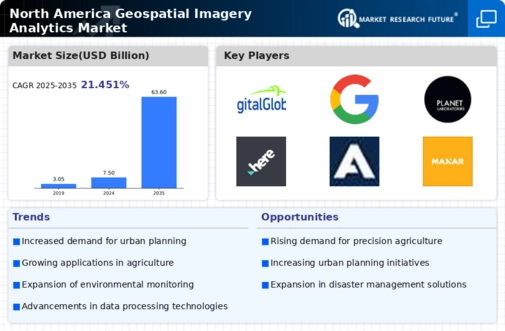Growing Adoption of Cloud-Based Solutions
The geospatial imagery-analytics market is witnessing a growing adoption of cloud-based solutions, which offer scalability and flexibility for data storage and processing. Organizations are increasingly migrating their geospatial analytics operations to the cloud to take advantage of advanced computing capabilities and cost efficiencies. This shift is particularly relevant for small and medium-sized enterprises that may lack the resources for extensive on-premises infrastructure. The cloud-based segment is expected to account for over 40% of the market share by 2027, driven by the need for real-time data access and collaboration among stakeholders. As more businesses recognize the benefits of cloud technology, the demand for geospatial imagery-analytics solutions is likely to expand.
Rising Demand for Environmental Monitoring
The geospatial imagery-analytics market is significantly influenced by the rising demand for environmental monitoring solutions. As climate change concerns escalate, organizations are increasingly utilizing geospatial analytics to track environmental changes, assess natural resources, and manage disaster response. The market for environmental monitoring is expected to reach $5 billion by 2026, reflecting a growing recognition of the importance of data-driven decision-making in sustainability efforts. This trend is further supported by government regulations aimed at promoting environmental protection, which necessitate the use of advanced geospatial technologies for compliance and reporting. Consequently, the demand for sophisticated imagery analytics tools is likely to continue its upward trajectory.
Technological Advancements in Remote Sensing
The geospatial imagery-analytics market is experiencing a surge due to rapid technological advancements in remote sensing technologies. Innovations such as high-resolution satellite imagery and aerial drones are enhancing data collection capabilities. For instance, the integration of LiDAR technology allows for precise topographical mapping, which is crucial for urban planning and environmental monitoring. The market is projected to grow at a CAGR of approximately 15% over the next five years, driven by these advancements. Furthermore, the increasing availability of open-source satellite data is enabling more organizations to leverage geospatial analytics, thereby expanding the user base and applications across various sectors, including agriculture, forestry, and disaster management.
Increased Investment in Smart City Initiatives
The geospatial imagery-analytics market is benefiting from increased investment in smart city initiatives across North America. Cities are leveraging geospatial analytics to enhance urban planning, optimize resource allocation, and improve public services. For example, the integration of geospatial data into transportation systems can lead to more efficient traffic management and reduced congestion. According to recent estimates, investments in smart city technologies are projected to exceed $100 billion by 2025, creating substantial opportunities for geospatial analytics providers. This trend indicates a shift towards data-driven governance, where real-time geospatial insights play a pivotal role in shaping urban environments and enhancing the quality of life for residents.
Emerging Applications in Agriculture and Precision Farming
The geospatial imagery-analytics market is experiencing growth due to emerging applications in agriculture and precision farming. Farmers are increasingly utilizing geospatial analytics to optimize crop yields, monitor soil health, and manage irrigation more effectively. The use of satellite imagery and drones allows for detailed analysis of agricultural fields, enabling data-driven decisions that enhance productivity. The precision agriculture market is projected to reach $12 billion by 2027, indicating a robust demand for geospatial analytics tools tailored to agricultural needs. This trend highlights the potential for geospatial imagery-analytics to transform traditional farming practices into more efficient and sustainable operations.






















Leave a Comment